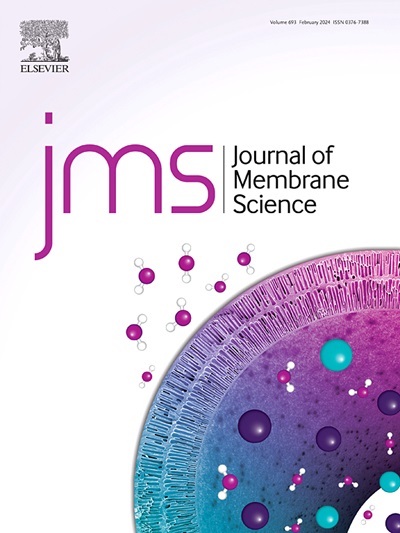在中等温度下用于氢分离的致密焦磷酸盐质子导电膜
IF 8.4
1区 工程技术
Q1 ENGINEERING, CHEMICAL
引用次数: 0
摘要
在中温环境下工作的透氢膜由于能有效地将氢气的生产和应用结合起来,近年来受到了广泛的关注。其中,在中温条件下具有高质子导电性的焦磷酸盐型膜是理想的候选膜。然而,焦磷酸盐材料的低相对密度对实际应用构成了巨大的挑战,焦磷酸盐型膜用于氢分离的报道很少。本研究通过在SnP2O7的sn位点添加ZnO助烧剂并掺杂低价Mg2+离子,获得了致密的氢透膜。制备的Sn0.9Mg0.1P2O7-ZnO (SM0.1P-ZnO)膜的相对密度和电导率分别高达94.6%和0.08 mS cm−1(400℃)。当扫侧加湿氩气,进料侧加80% - 20%的氢气时,SM0.1P-ZnO膜的最大氢渗透通量为4.03 mol h−1 m−2。此外,SM0.1P-ZnO膜在400℃下运行300 h时表现出良好的稳定性,有望在中温条件下实现实际的氢分离。本文章由计算机程序翻译,如有差异,请以英文原文为准。

A dense pyrophosphate proton-conducting membrane for hydrogen separation at intermediate temperatures
The hydrogen permeation membranes that work at intermediate temperatures have received significant attention in recent years because they can efficiently couple hydrogen production and applications. Among them, the pyrophosphate-type membranes with high protonic conductivity at intermediate temperatures are ideal candidates. However, the low relative density of pyrophosphate materials is a huge challenge for practical applications, and few pyrophosphate-type membranes were reported for hydrogen separation. In this work, by adding ZnO sintering aid and doping the low-valence Mg2+ ions into the Sn-site of the SnP2O7, dense membranes are obtained for hydrogen permeation. The relative density and conductivity of the developed Sn0.9Mg0.1P2O7–ZnO (SM0.1P–ZnO) membranes are up to 94.6 % and 0.08 mS cm−1 (at 400 °C), respectively. The maximum hydrogen permeation flux of the SM0.1P–ZnO membrane is 4.03 mol h−1 m−2 when humidified Ar is supplied on the sweeping side and 80 % H2–20 % He is supplied on the feed side. In addition, the SM0.1P–ZnO membrane exhibits good stability during 300 h of operation at 400 °C, which is promising for practical hydrogen separation at intermediate temperatures.
求助全文
通过发布文献求助,成功后即可免费获取论文全文。
去求助
来源期刊

Journal of Membrane Science
工程技术-高分子科学
CiteScore
17.10
自引率
17.90%
发文量
1031
审稿时长
2.5 months
期刊介绍:
The Journal of Membrane Science is a publication that focuses on membrane systems and is aimed at academic and industrial chemists, chemical engineers, materials scientists, and membranologists. It publishes original research and reviews on various aspects of membrane transport, membrane formation/structure, fouling, module/process design, and processes/applications. The journal primarily focuses on the structure, function, and performance of non-biological membranes but also includes papers that relate to biological membranes. The Journal of Membrane Science publishes Full Text Papers, State-of-the-Art Reviews, Letters to the Editor, and Perspectives.
 求助内容:
求助内容: 应助结果提醒方式:
应助结果提醒方式:


